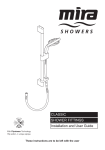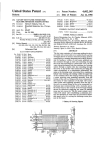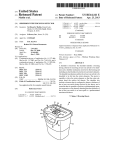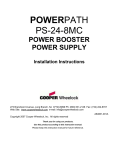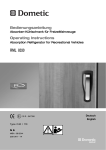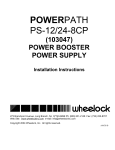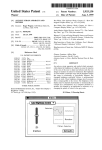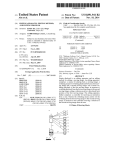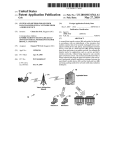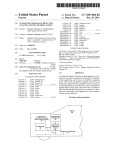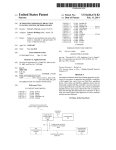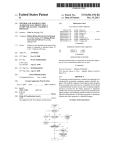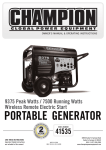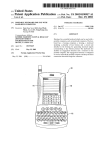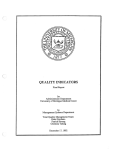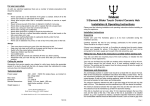Download Apparatus for topical negative pressure therapy
Transcript
US008617129B2 (12) United States Patent (10) Patent N0.: (45) Date of Patent: Hartwell (54) APPARATUS FOR TOPICAL NEGATIVE 4,735,606 A 4,936,834 A 5,207,641 A PRESSURE THERAPY (75) Inventor: Edward Hartwell, York (GB) (73) Assignee: Smith & Nephew PLC, London (GB) (*) Notice: (22) PCT Filed: Nov. 11, 2008 (86) PCT No.: PCT/GB2008/051048 4/1988 Davison 6/1990 Beck et al. 5/1993 Allton 5,370,610 A 12/1994 Reynolds 11/2000 Hunt et al. 1/2008 Hunt et al. 6/2009 Hunt et al. (Continued) FOREIGN PATENT DOCUMENTS U.S.C. 154(b) by 572 days. 12/746,499 Dec. 31, 2013 6,142,982 A 7,316,672 B1 7,553,306 B1 Subject to any disclaimer, the term of this patent is extended or adjusted under 35 (21) Appl. No.: US 8,617,129 B2 GB W0 2 307 180 WO 92/12369 5/1997 7/1992 (Continued) OTHER PUBLICATIONS § 371 (0X1)’ (2), (4) Date: (87) International Search Report from PCT/ GB2008/051048 mailed Oct. 2, 2009 in 7 pages. Sep. 24, 2010 (Continued) PCT Pub. No.: WO2009/071926 Primary Examiner * Melanie Hand PCT Pub. Date: Jun. 11, 2009 (74) Attorney, A gent, or Firm * Knobbe, Martens, Olson & (65) US 2010/0280422 A1 (30) (GB) ................................. .. 07238769 (2006.01) ........................................................ .. 604/313 Field of Classi?cation Search USPC ................................ .. 604/304, 313, 319, 540 See application ?le for complete search history. (56) References Cited U.S. PATENT DOCUMENTS 3,276,472 A 3,750,704 A 10/1966 Jinkens et al. 8/1973 Burke et a1. pressure therapy to a Wound site are described, the apparatus comprising: vacuum generating means for generating a nega tive pressure at said Wound site said vacuum generating means being operably connected to a dressing at said Wound site by aspiration conduit means; pressure sensing conduit US. Cl. USPC (58) (57) ABSTRACT Apparatus and a method for the provision of topical negative Int. Cl. A61M 1/00 (52) Nov. 4, 2010 Foreign Application Priority Data Dec. 6, 2007 (51) Bear, LLP Prior Publication Data means in ?uid communication with said aspiration conduit means at a junction adjacent said dressing; ?rst pressure sensing means between said junction and said vacuum gen erating means; second pressure sensing means operably asso ciated with said pressure sensing conduit means; diagnostic means in communication with said ?rst and second pressure sensing means; and control means in communication with said diagnostic means for controlling pressure in said aspira tion and said pressure sensing conduit means. 14 Claims, 9 Drawing Sheets US 8,617,129 B2 Page 2 (56) References Cited U_g_ PATENT DOCUMENTS 7,670,323 7,758,555 7 , 811269 , 2005/0131327 B2 B2 B2 A1 3/2010 7/2010 10/2010 6/2005 Hunt et al. Kelch etal. Bo yn ton et al. Lockwood et a1. 2007/0167927 A1* 7/2007 2008/0071216 A1 2010/0160878 A1 2013/0150813 A1 3/2008 Locke et a1. 6/2010 Hunt et al. 6/2013 Gordon et al. Hunt et al. .................. .. 604/313 FOREIGN PATENT DOCUMENTS W0 W0 99/19013 4/1999 W0 WO 2004/016313 2/2004 W0 WO 2004/037334 W0 W0 W0 W0 W0 W0 W0 W0 WO WO WO WO WO WO WO WO 2005/046760 2005/046761 2005/046762 2005/061025 2005/105180 2007/031765 2007/087810 2008/141470 5/2004 5/2005 5/2005 5/2005 7/2005 11/2005 3/2007 8/2007 11/2008 OTHER PUBLICATIONS Info V.A.C. User Manual, KCI, Dec. 2006 in 76 pages. International Preliminary Report on Patentability issued on Jun. 8, 2010 in International Application No. PCT/GB2008/051048 in 9 pages. * cited by examiner US. Patent Dec. 31, 2013 Sheet 1 019 US 8,617,129 B2 i p .wE _ kf, m US. Patent Dec. 31, 2013 Sheet 2 019 US 8,617,129 B2 i 1F.2 a:U a @N .wE N US. Patent Dec. 31, 2013 Sheet 3 of9 US 8,617,129 B2 US. Patent Dec. 31, 2013 Sheet 4 019 US 8,617,129 B2 US. Patent Dec. 31, 2013 Sheet 5 of9 US 8,617,129 B2 US. Patent Dec. 31, 2013 Sheet 6 of9 US 8,617,129 B2 US. Patent Dec. 31, 2013 266 Sheet 7 of9 US 8,617,129 B2 202 260 29s 2911/ 214 204 263/218) 292 FIG. 8 US 8,617,129 B2 1 2 APPARATUS FOR TOPICAL NEGATIVE PRESSURE THERAPY With the additional step of providing means for the supply and application of physiologically active agents to the Wound site/dressing to promote Wound healing. The content of the above references is included herein by reference. HoWever, the above apparatus and methods are generally only applicable to a patient When hospitalised as the appara CROSS-REFERENCE TO RELATED APPLICATIONS This application is a US. National Phase of the PCT Inter national Application No. PCT/GB2008/051048 ?led on Nov. tus is complex, needing people having specialist knoWledge 11,2008, designating the US. and published on Jun. 11,2009 in hoW to operate and maintain the apparatus, and also rela as WO 2009/071926 Which claims priority to Great Britain tively heavy and bulky, not being adapted for easy mobility Patent Application No. 07238769, ?led on Dec. 6, 2007. The outside of a hospital environment by a patient, for example. Some patients having relatively less severe Wounds Which do not require continuous hospitalisation, for example, but Whom nevertheless Would bene?t from the prolonged appli disclosure of both prior applications is incorporated by refer ence in their entirety and should be considered a part of this speci?cation. cation of TNP therapy, could be treated at home or at Work BACKGROUND OF THE INVENTION subject to the availability of an easily portable and maintain able TNP therapy apparatus. 1. Field of the Invention The present invention relates to apparatus and a method for the application of topical negative pressure (TNP) therapy to It is desirable to be able to differentiate betWeen and to measure separately the pressures being applied immediately 20 adjacent a vacuum pump connected to TNP apparatus and a 25 dressing and the actual pressure being applied at or adjacent a Wound dressing itself. This is because the pressure (reduc tion) being applied by a vacuum pump may not necessarily be that pressure Which actually exists at the Wound dressing. For example, an aspirant tube may be kinked or otherWise Wounds. In particular, but not exclusively, the present inven tion relates to the control and monitoring of reduced pressure at a Wound site. 2. Background of the Invention There is much prior art available relating to the provision of apparatus and methods of use thereof for the application of TNP therapy to Wounds together With other therapeutic pro blocked, perhaps by aspirated ?uids, and although a pressure measured by a sensor adjacent the pump may indicate that a cesses intended to enhance the effects of the TNP therapy. desired pressure is being applied, the actual pressure at the Examples of such prior art include those listed and brie?y Wound site may be very different. GB-A-2 307 180 describes a portable TNP therapy unit Which may be carried by a patient clipped to belt or harness. described beloW. 30 TNP therapy assists in the closure and healing of Wounds by reducing tissue oedema; encouraging blood ?oW and The portable TNP apparatus described permits the measure granulation of tissue; removing excess exudates and may ment of pressure applied at the Wound site and also that pressure generated by a vacuum pump. However, the means reduce bacterial load and thus, infection to the Wound. Fur thermore, TNP therapy permits less outside disturbance of the Wound and promotes more rapid healing. In our co-pending International patent application, WO 35 2004/037334, apparatus, a Wound dressing and a method for aspirating, irrigating and cleansing Wounds are described. In very general terms, this invention describes the treatment of a 40 of conveying the respective pressures is by a multi-lumen tube Which is complex and expensive to produce and Which also requires a made-to-?t connector and dressing in order to connect the multi-lumen tube to a Wound. Furthermore, the apparatus applies a vacuum to the dressing via the Waste canister, therefore, the Waste canister itself is a complex and Wound by the application of topical negative pressure (TNP) expensive moulding needing to separate the various functions therapy for aspirating the Wound together With the further provision of additional ?uid for irrigating and/or cleansing the Wound, Which ?uid, comprising both Wound exudates and irrigation ?uid, is then draWn off by the aspiration means and necessary routing thereof. of the lumens in the multi-lumen tube and provide for the 45 circulated through means for separating the bene?cial mate rials therein from deleterious materials. The materials Which are bene?cial to Wound healing are recirculated through the Wound dressing and those materials deleterious to Wound healing are discarded to a Waste collection bag or vessel. It is an aim of the present invention to at least partly miti 50 In our co-pending International patent application, WO 2005/04670, apparatus, a Wound dressing and a method for It is an aim of embodiments of the present invention to easily and economically measured. 55 sure therapy to a Wound site, the apparatus comprising: vacuum generating means for generating a negative pressure at said Wound site said vacuum generating means being oper 60 optimum temperature, for example, to have the most e?ica ably connected to a dressing at said Wound site by aspiration conduit means; pressure sensing conduit means in ?uid com munication With said aspiration conduit means at a junction cious therapeutic effect on the Wound. In our co-pending International patent application, WO 2005/105180, apparatus and a method for the aspiration, irri gation and/or cleansing of Wounds are described. Again, in very general terms, this document describes similar apparatus to the tWo previously mentioned documents hereinabove but According to a ?rst aspect of the present invention there is provided apparatus for the provision of topical negative pres irrigation and cleansing of the Wound, hoWever, it further includes the important additional step of providing heating means to control the temperature of that bene?cial material being returned to the Wound site/dressing so that it is at an gate the above-mentioned problems in measuring pressures in knoWn portable TNP apparatus. provide portable TNP apparatus Where pressures at different locations in the overall apparatus to dressing system may be cleansing a Wound using aspiration, irrigation and cleansing Wounds are described. Again, in very general terms, the invention described in this document utilises similar appara tus to that in WO 2004/ 037334 With regard to the aspiration, SUMMARY OF SOME EXEMPLIFYING EMBODIMENTS 65 adjacent said dressing; ?rst pressure sensing means betWeen said junction and said vacuum generating means; second pressure sensing means operably associated With said pres sure sensing conduit means; diagnostic means in communi cation With said ?rst and second pressure sensing means; and US 8,617,129 B2 3 4 control means in communication With said diagnostic means ing are available commercially and of loW cost. One of the lumens may be connected to the aspiration conduit, vacuum generating means and ?rst pressure sensing means and the second lumen to the pressure sensing conduit means and the second pressure sensing means. Thus the junction betWeen the aspiration conduit means and the pressure sensing conduit means may be provided inside the dressing in the drain/ for controlling pressure in said aspiration and said pressure sensing conduit means. The invention is comprised in part of an overall apparatus for the provision of TNP therapy to a patient in almost any environment. The apparatus is lightweight, may be mains or battery poWered by a rechargeable battery pack contained aspirant conduit portion. Within a device (henceforth, the term “device” is used to connote a unit Which may contain all of the control, poWer supply, poWer supply recharging, electronic indicator means and means for initiating and sustaining aspiration functions to It is envisaged that the negative pressure range for the apparatus embodying the present invention may be betWeen about —50 mmHg and —200 mmHg (note that these pressures a Wound and any further necessary functions of a similar are relative to normal ambient atmospheric pressure thus, nature). When outside the home, for example, the apparatus —200 mmHg Would be about 560 mmHg in practical terms). may provide for an extended period of operation on battery poWer and in the home, for example, the device may be connected to the mains by a charger unit Whilst still being Aptly, the pressure range may be betWeen about —75 mmHg and —150 mmHg. Alternatively a pressure range of up to —75 mmHg, up to —80 mmHg or over —80 mmHg can be used. used and operated by the patient. The overall apparatus of Which the present invention is a part may comprise: a dressing covering the Wound and seal ing at least an open end of an aspiration conduit to a cavity 20 formed over the Wound by the dressing; an aspiration tube comprising at least one lumen therethrough leading from the Wound dressing to a Waste material canister for collecting and holding Wound exudates/Waste material prior to disposal; and, a poWer, control and aspiration initiating and sustaining and sustaining aspiration of the Wound/ dressing may be situ ated betWeen the dressing and Waste canister, hoWever, in a 25 device associated With the Waste canister. The dressing covering the Wound may be any type of dress ing normally employed With TNP therapy and, in very general terms, may comprise, for example, a semi-permeable, ?ex ible, self-adhesive drape material, as is knoWn in the dressings Also aptly a pressure range of beloW —75 mmHg could be used. Alternatively a pressure range of over —100 mmHg could be used or over —150 mmHg. The aspiration conduit at its distal end remote from the dressing may be attached to the Waste canister at an inlet port or connector. The device containing the means for initiating 30 art, to cover the Wound and seal With surrounding sound tissue to create a sealed cavity or void over the Wound. There may preferred embodiment of the apparatus embodying the present invention, the device may aspirate the Wound/dress ing via the canister thus, the Waste canister may preferably be sited betWeen the Wound/dressing and device. The aspiration conduit at the Waste material canister end may preferably be bonded to the Waste canister to prevent inadvertent detachment When being caught on an obstruction, for example. aptly be a porous barrier and support member in the cavity The canister may be a plastics material moulding or a betWeen the Wound bed and the covering material to enable an composite unit comprising a plurality of separate mouldings. even vacuum distribution to be achieved over the area of the 35 The canister may aptly be translucent or transparent in order to visually determine the extent of ?lling With exudates. HoW Wound. The porous barrier and support member being, for example, a gauZe, a foam, an in?atable bag or knoWn Wound ever, the canister and device may in some embodiments pro contact type material resistant to crushing under the levels of vide automatic Warning of imminent canister full condition and may also provide means for cessation of aspiration When the canister reaches the full condition. The canister may be provided With ?lters to prevent the exhaust of liquids and odours therefrom and also to prevent the expulsion of bacteria into the atmosphere. Such ?lters may comprise a plurality of ?lters in series. Examples of suitable ?lters may comprise hydrophobic ?lters of 0.2 pm vacuum created and Which permits transfer of Wound exu dates across the Wound area to the aspiration conduit sealed to the ?exible cover drape over the Wound. 40 The aspiration conduit means may be a plain ?exible tube, for example, having a single lumen therethrough and made from a plastics material compatible With raW tissue, for example. A portion of the tube sited Within the sealed cavity 45 over the Wound may have a structure to enable continued pore siZe, for example, in respect of sealing the canister aspiration and evacuation of Wound exudates Without becom against bacteria expulsion and 1 pm against liquid expulsion. ing constricted or blocked even at the higher levels of the negative pressure range envisaged. Where an aspiration con Aptly, the ?lters may be sited at an upper portion of the Waste canister in normal use, that is When the apparatus is being used or carried by a patient the ?lters are in an upper duit having a single lumen is combined into the dressing to aspirate the Wound, the pressure sensing conduit may be connected in ?uid communication With the aspiration conduit 50 position and separated from the exudate liquid in the Waste canister by gravity. Furthermore, such an orientation keeps at a junction adjacent the dressing by means of a holloW “T” or “Y” piece, for example. Alternatively to a plain single lumen conduit, the dressing the Waste canister outlet or exhaust exit port remote from the exudate surface. 55 over the Wound site may be provided With a purpose made safeguard against leakage of the canister When full and being changed and disposed of. Added advantages of a gel matrix drain/aspirant conduit portion sealed to a dressing sealing ?lm or drape and Which is connected to the vacuum aspirant conduit and to the pressure sensing conduit means outside the dressing boundary. In this regard the drain/aspirant conduit 60 The Waste canister may also be provided With suitable means to prevent leakage thereof both When detached from the device unit and also When the aspiration conduit is the sealing drape or ?lm. The drain/aspirant conduit portion may also have an aspirant conduit portion having tWo lumens Within the exudate storing volume of the Waste canister are that it prevents excessive movement, such as slopping, of the liquid, minimises bacterial groWth and minimises odours. portion may have a ?rst portion resistant to being occluded or closed up due to the pressure applied thereto by the outer atmospheric pres sure bearing doWn upon the drain portion via therethrough in the portion Which exits the dressing. Such drain/aspirant conduit portions for incorporation into a dress Aptly the Waste canister may be ?lled With an absorbent gel such as ISOLYSEL (trade mark), for example, as an added 65 detached from the Wound site/ dressing. The canister may have suitable means to prevent emptying by a user (Without tools or damage to the canister) such that a US 8,617,129 B2 5 6 full or otherwise end-of-life canister may only be disposed of sensor mean sWill initially be that of the vacuum level set by the user or clinician and that sensed by the second pressure sensor Will be atmospheric. HoWever, after a short time the vacuum pump Will clear the aspirant conduit and the pressure sensed by both pressure sensor means Will be substantially With Waste ?uid still contained. The device and Waste canister may have mutually comple mentary means for connecting a device unit to a Waste can ister Whereby the aspiration means in the device unit auto such that there is a continuous aspiration path from the Wound atmospheric or close thereto at Which point the control sys tem, in response to information stored in the memory thereof site/dressing to an exhaust port on the device. Will close the valve and normal operation of the apparatus Will matically connects to an evacuation port on the Waste canister Aptly, the exhaust port from the ?uid path through the be resumed. Where there is a leak of ambient air into the apparatus is provided With ?lter means to prevent offensive system due, for example, to an inadequately applied dressing odours from being ejected into the atmosphere. drape, then the pressures sensed by the tWo sensor means Will In general terms the device unit comprises an aspirant pump; means for monitoring pressure applied by the aspirant be approximately equal and in Which case the control system Will not open the valve but information in the control system memory related, for example, to the rate of pumping of the pump, the ?rst pressure sensing means; a ?oWmeter to moni tor ?uid ?oW through the aspirant pump; a control system Which controls the aspirant pump in response to signals from vacuum pump and the rate of attaining a required vacuum sensors such as the pressure monitoring means and the ?oW dressing integrity may need checking, for example. meter, for example, and Which control system also controls a poWer management system With regard to an on-boardbattery pack and the charging thereof and lastly a user interface system Whereby various functions of the device such as pres sure level set point, for example, may be adjusted (including stopping and starting of the apparatus) by a user. The device unit may contain all of the above features Within a single uni?ed casing. In the present invention the device may also include the second pressure sensor connected to the pressure sensing conduit means and the diagnostic means. The diagnostic means may be comprised in the control system to receive signals from the ?rst and second pressure sensors and, in response to softWare in the control, system operate various level being loWer than speci?ed may trigger an alarm that the The valve may preferably be provided With a microbial ?lter to ensure that bacteria cannot either enter the device or 20 be expelled to atmosphere. In vieW of the fact that the device unit contains the majority of the intrinsic equipment cost therein ideally it Will also be able to survive impact, tolerate cleaning in order to be reus able by other patients. 25 30 functions depending upon the signals received. In terms of pressure capability the aspiration means may be able to apply a maximum pressure drop of at least —200 mmHg to a Wound site/ dressing. The apparatus is capable of maintaining a predetermined negative pressure even under conditions Where there is a small leak of air into the system and a high exudate ?oW. The pressure control system may prevent the minimum pressure achieved from exceeding for example —200 mmHg The pressure sensing conduit may be connected to a valve so as not to cause undue patient discomfort. The pressure Which When closed effectively forms With pressure sensing required may be set by the user at a number of discreet levels conduit a closed branch of the aspiration conduit and in Which branch the second pressure sensing means is located. 35 Depending upon the signals received by the control system from the ?rst and second pressure sensing means, the control system may open the valve effectively to expose the pressure sensing conduit to atmospheric pressure. The response in pressures sensed by the ?rst and second pressure sensor means may be related to softWare in the control system and trigger appropriate alarms depending on the pressure responses. For example, the control system may be provided With softWare Which recognises When the difference in pres sure betWeen the aspirant conduit and the pressure sensing such as —50, —75, —100, —125, —150, —175 mmHg, for example, depending upon the needs of the Wound in question and the advice of a clinician. Thus suitable pressure ranges in use may be from —25 to —80 mmHg, or —50 to —76 mmHg, or —50 to —75 mmHg as examples. The control system may also 40 advantageously be able to maintain the set pressure Within a tolerance band of +/—l0 mmHg of the set point for 95% of the time the apparatus is operating given that leakage and exuda tion rates are Within expected or normal levels. Aptly, the control system may trigger alarm means such as 45 a ?ashing light, buZZer or any other suitable means When various abnormal conditions apply such as, for example: conduit as sensed by the ?rst and second pressure sensing pressure outside set value by a large amount due to a gross means reaches or exceeds a predetermined level. When this leak of air into system; duty on the aspiration pump too high due to a relatively smaller leakage of air into the system; pressure differential betWeen Wound site and pump is too high due, for example, to a blockage or Waste canister full. The apparatus of the present invention may be provided happens the control system may open the valve to atmo sphere. If, for example, there is a kink in the aspiration con duit effectively stopping ?oW in the aspirant conduit then the ?rst pressure sensing means Will continue to read a pressure equal to a preset pressure for the vacuum pump to achieve Whereas the second pressure sensing means Will shoW atmo spheric pressure. The control system may issue an appropri ate alarm to check the condition of the aspirant conduit With a carry case and suitable support means such as a shoul der strap or harness, for example. The carry case may be 55 adapted to conform to the shape of the apparatus comprised in the joined together device and Waste canister. In particular, means. Alternatively, if the aspirant conduit means is not blocked due to a kink, for example, it may be blocked due to the Waste canister being full and unable to accept any more Wound exudate ?uid, in Which case the control system Will issue an alarm to the need to replace the Waste canister and/or the carry case may be provided With a bottom opening ?ap to check the aspirant conduit. In the event that the aspirant conduit is blocked merely due to aspirated Wound exudate then opening of the valve Will admit air into the system and varying the therapy applied by the apparatus. enable the vacuum pump to aspirate the exudate into the Waste canister and so clear the aspirant conduit. In this latter case on opening the valve the pressure sensed by the ?rst pressure permit the Waste canister to be changed Without complete removal of the apparatus form the carry case. The carry case may be provided With an aperture covered by a displaceable ?ap to enable user access to a keypad for 65 According to a second aspect of the present invention, there is provided a method for the topical negative pressure treat ment of a Wound site using the apparatus of the ?rst aspect, the method comprising the steps of: providing vacuum generat ing means for generating a negative pressure at said Wound US 8,617,129 B2 7 8 site said vacuum generating means being operably connected to a dressing at said Wound site by aspiration conduit means; providing pressure sensing conduit means in ?uid communi cation With said aspiration conduit means at a junction adja cent said dressing; providing ?rst pressure sensing means betWeen said junction and said vacuum generating means; providing second pressure sensing means operably associ ated With said pressure sensing conduit means; providing ister and the second lumen being for admitting an air bleed into the system, preferably close to the dressing so as to ensure continuous aspiration of ?uid from the Wound cavity. BRIEF DESCRIPTION OF THE DRAWINGS diagnostic means in communication With said ?rst and sec ond pressure sensing means; and providing control means in communication With said diagnostic means for controlling pressure in said aspiration and said pressure sensing conduit means; sensing pressures at said ?rst and second pressure 10 FIG. 2 shoWs a similar generalised schematic block dia sensor means and triggering an appropriate alarm When pres sure levels sensed by said sensor means lie outside of a preset pressure differential stored in memory means in said control gram to FIG. 1 and shoWing ?uid paths therein; FIG. 3 shoWs a generalised schematic block diagram simi lar to FIG. 1 but of a device unit only and shoWing poWerpaths for the various poWer consuming/producing features of the system. Desirably, said method also includes the optional provision apparatus; of valve means associated With the pressure sensing conduit means, said valve being controlled by said control system to 20 open and close said pressure sensing conduit means to atmo spheric pressure. According to a third aspect of the present invention there is provided a drainage conduit member for use in topical nega tive pressure therapy, the drainage conduit member compris ing an exudate collecting portion having a plurality of exudate aspiration ?oW apertures therein, the exudate collecting potion being contained, in use, beneath a Wound covering and sealing dressing drape; an aspirant conduit portion having a single lumen therethrough in ?uid communication With the exudate collecting portion; and a dual lumen portion having both lumens in ?uid communication With the single lumen 25 30 of the apparatus; FIG. 9 shoWs a cross section through a Waste canister of the apparatus of FIGS. 5 to 8; FIGS. 10A and 10B shoW a schematic draWing of a ?rst embodiment of the present invention and part of a control 35 system related to the operation of vacuum pump means and a control valve and, a schematic cross section of a Wound site, respectively; a chamber in the ?attened portion Which chamber being in ?uid ?oW communication With one end of the single lumen FIGS. 11A to 11D Which shoW various vieWs and cross 40 provided With internal ribs Within the chamber formed, to prevent the inner surfaces of the tWo opposing Walls from contacting each other and so closing the chamber Within to exudate ?uid ?oW. The ribs holding the Walls apart under vacuum conditions to permit continuous ?uid ?oW there FIG. 6 shoWs a perspective vieW of an assembled device FIG. 8 shoWs a partially sectioned side elevation vieW through the interface betWeen a Waste canister and device unit opposing Walls may be joined by side pieces thereby forming aspirant conduit portion. The opposing Wall portions may be FIG. 4 shoWs a similar generalised schematic block dia gram to FIG. 3 of the device unit and shoWing control system data paths for controlling the various functions and compo nents of the apparatus; FIG. 5 shoWs a perspective vieW of an apparatus; unit of the apparatus of FIG. 5; FIG. 7 shoWs an exploded vieW of the device unit of FIG. 6; aspirant conduit portion. The exudate collecting portion may comprise a ?attened shape having tWo opposing Walls each having exudate ?oW apertures therein for collecting Wound exudate, the tWo In order that the present invention may be more fully under stood, examples Will noW be described by Way of illustration only With reference to the accompanying draWings, of Which: FIG. 1 shoWs a generalised schematic block diagram shoW ing a general vieW of an apparatus and the constituent appa ratus features thereof; sections of a purpose made drain/aspirant conduit for incor poration With a Wound dressing and for use With apparatus according to the present invention; and, FIGS. 12A to 12C Which shoW an embodiment of a ?oW splitting device for installation in an aspirant conduit. 45 through. DETAILED DESCRIPTION OF SOME EXEMPLIFYING EMBODIMENTS The dual lumen portion may provide one portion for aspi Referring noW to FIGS. 1 to 4 of the draWings and Where rated exudate ?uid ?oW therethrough toWards a Waste canister Whilst the second lumen may, for example, be provided for the purpose of admitting an air bleed into the system, prefer the same or similar features are denoted by common refer 50 ence numerals. ably close to the dressing, so as to ensure continuous aspirant ?uid ?oW under all conditions. FIG. 1 shoWs a generalised schematic vieW of an apparatus 10 of a portable topical negative pressure (TNP) system. It The ?attened shaped exudate collecting portion may be formed in other shapes and constructions according to the requirements of a particular Wound formation. According to a fourth aspect of the present invention there is provided an adapter for use in topical negative pressure 55 Will be understood that embodiments of the present invention are generally applicable to use in such a TNP system. Brie?y, negative pressure Wound therapy assists in the closure and healing of many forms of “hard to heal” Wounds by reducing tissue oedema; encouraging blood ?oW and granular tissue therapy, the adapter comprising a connecting spigot potion formation; removing excess exudate and may reduce bacte having a ?uid ?oW inlet conduit therethrough; a body portion rial load (and, therefore, infection). In addition the therapy Wherein the inlet conduit communicates With tWo ?uid ?oW 60 alloWs for less disturbance of a Wound leading to more rapid passages; the body portion also including means for receiving healing. The TNP system is detailed further hereinafter but in tWo ?uid ?oW lumens, both ?uid ?oW lumens being in ?uid communication With each other in the body portion. summary includes a portable body including a canister and a device With the device capable of providing an extended The adapter may be used to connect to a single lumen aspirant conduit exiting a sealed Wound cavity under a dress ing drape during TNP therapy; one lumen in the adapter being period of continuous therapy Within at least a one year life span. The system is connected to a patient via a length of tubing With an end of the tubing operably secured to a Wound for aspiration of Wound exudate to an associated Waste can dressing on the patient. 65 US 8,617,129 B2 10 More particularly, as shown in FIG. 1, the apparatus com prises an aspiration conduit 12 operably and an outer surface thereof at one end sealingly attached to a dressing 14. The dressing 14 Will not be further described here other than to say that it is formed in a knoWn manner from Well knoW materials to those skilled in the dressings art to create a sealed cavity over and around a Wound to be treated by TNP therapy With the apparatus embodying the present invention. PoWer is pro vided mainly by the battery pack 56 When the user is outside their home or Workplace, for example, hoWever, poWer may also be provided by an external mains 74 supplied charging the apparatus of the present invention. The aspiration conduit has an in-line connector 16 comprising connectorportions 18, 20 intermediate its length betWeen the dressing 14 and a Waste canister 22. The aspiration conduit betWeen the connector portion 20 and the canister 22 is denoted by a different refer ence numeral 24 although the ?uid path through conduit portions 12 and 24 to the Waste canister is continuous. The connector portions 18, 20 join conduit portions 12, 24 in a tem 66 is included so as to be able to control poWer of the TNP unit 72 Which When connected to the device 32 by the socket 68 is capable of both operating the device and recharging the battery pack 56 simultaneously. The poWer management sys system. The TNP system is a rechargeable, battery poWered system but is capable of being run directly from mains elec tricity as Will be described hereinafter more fully With respect to the further ?gures. If disconnected from the mains the battery has enough stored charge for approximately 8 hours of use in normal conditions. It Will be appreciated that batteries having other associated life times betWeen recharge can be utilised. For example batteries providing less than 8 hours or greater than 8 hours can be used. When connected to the mains the device Will run off the mains poWer and Will simul leak-free but disconnectable manner. The Waste canister 22 is provided With ?lters 26 Which prevent the escape via an exit port 28 of liquid and bacteria from the Waste canister. The ?lters may comprise a 1 pm hydrophobic liquid ?lter and a 0.2 pm bacteria ?lter such that all liquid and bacteria is con?ned taneously recharge the battery if depleted from portable use. 20 to an interior Waste collecting volume of the Waste canister 22. The exit port 28 of the Waste canister 22 mates With an entry/ suction port 30 of a device unit 32 by means of mutually sealing connector portions 34, 36 Which engage and seal together automatically When the Waste canister 22 is attached to the device unit 32, the Waste canister 22 and device unit 32 there is a signi?cant leak, battery recharge Will take longer than if the Wound is small and Well sealed. FIG. 4 shoWs the device 32 part of the apparatus embody 25 being held together by catch assemblies 38, 40. The device unit 32 comprises an aspirant pump 44, an aspirant pressure monitor 46 and an aspirant ?oWmeter 48 operably connected together. The aspiration path takes the aspirated ?uid Which in 30 the case of ?uid on the exit side of exit port 28 is gaseous through a silencer system 50 and a ?nal ?lter 52 having an activated charcoal matrix Which ensures that no odours escape With the gas exhausted from the device 32 via an exhaust port 54. The ?lter 52 material also serves as noise 35 reducing material to enhance the effect of the silencer system 50. The device 32 also contains a battery pack 56 to poWer the apparatus Which battery pack also poWers the control system ing the present invention and the data paths employed in the control system for control of the aspirant pump and other features of the apparatus. A key purpose of the TNP system is to apply negative pressure Wound therapy. This is accom plished via the pressure control system Which includes the pump and a pump control system. The pump applies negative pressure; the pressure control system gives feedback on the pressure at the pump head to the control system; the pump control varies the pump speed based on the difference betWeen the target pressure and the actual pressure at the pump head. In order to improve accuracy of pump speed and hence provide smoother and more accurate application of the negative pressure at a Wound site, the pump is controlled by an auxiliary control system. The pump is from time to time alloWed to “free-Wheel” during its duty cycle by turning off 60 Which controls a user interface system 62 controlled via a keypad (not shoWn) and the aspiration pump 44 via signals The exact rate of battery recharge Will depend on the load on the TNP system. For example, if the Wound is very large or from sensors 46, 48. A poWer management system 66 is also the voltage applied to it. The spinning motor causes a “back electro-motive force” or BEMF to be generated. This BEMF provided Which controls poWer from the battery pack 56, the recharging thereof and the poWer requirements of the aspirant pump 44 and other electrically operated components. An measure of pump speed. The speed can thus be adjusted more accurately than can prior art pump systems. electrical connector 68 is provided to receive a poWer input jack 70 from a SELV poWer supply 72 connected to a mains supply 74 When the user of the apparatus or the apparatus itself is adjacent a convenient mains poWer socket. FIG. 2 shoWs a similar schematic representation to FIG. 1 but shoWs the ?uid paths in more detail. The Wound exudate 40 can be monitored and can be used to provide an accurate 45 In some embodiments of apparatus, actual pressure at a Wound site may not be measured but the difference betWeen a measured pressure (at the pump) and the Wound pressure is minimised by the use of large ?lters and large bore tubes 50 Wherever practical. If the pressure control measures that the pressure at the pump head is greater than a target pressure is aspirated from the Wound site/dressing 14 via the conduit 12, the tWo connector portions 18, 20 and the conduit 24 into device sends an alarm and displays a message alerting the the Waste canister 22. The Waste canister 22 comprises a user to a potential problem such as a leak. relatively large volume 80 in the region of 500 ml into Which exudate from the Wound is draWn by the aspiration system at (closer to atmospheric pressure) for a period of time, the 55 an entry port 82. The ?uid 84 draWn into the canister volume 80 is a mixture of both air draWn into the dressing 14 via the semi-permeable adhesive sealing drape (not shoWn) and liq uid 86 in the form of Wound exudates. The volume 80 Within the canister is also at a loWered pressure and the gaseous element 88 of the aspirated ?uids is exhausted from the can ister volume 80 via the ?lters 26 and the Waste canister exhaust exit port 28 as bacteria-free gas. From the exit port 28 of the Waste canister to the ?nal exhaust port 54 the ?uid is gaseous only. FIG. 3 shoWs a schematic diagram shoWing only the device portion of the apparatus and the poWer paths in the device of 60 In addition to pressure control a separate ?oW control sys tem can be provided. A ?oW meter may be positioned after the pump and is used to detect When a canister is full or the tube has become blocked. If the ?oW falls beloW a certain thresh old, the device sounds an alarm and displays a message alert ing a user to the potential blockage or full canister. Referring noW to FIGS. 5 to 9 Which shoW various vieWs and cross sections of a preferred embodiment of apparatus 200 embodying the present invention. The preferred embodi ment is of generally oval shape in plan and comprises a device 65 unit 202 and a Waste canister 204 connected together by catch arrangements 206. The device unit 202 has a liquid crystal display (LCD) 208, Which gives text based feedback on the Wound therapy being applied, and a membrane keypad 210, US 8,617,129 B2 11 12 the LCD being visible through the membrane of the keypad to piece 238 is provided With a socket member 298 to receive a enable a user to adjust or set the therapy to be applied to the charging jack from an external mains poWered battery charger (both not shoWn). Wound (not shown). The device has a loWer, generally trans verse face 212 in the centre of Which is a spigot 214 Which forms the suction/ entry port 216 to Which the aspiration means (to be described beloW) are connected Within the device unit. The loWer edge of the device unit is provided With a rebated peripheral male mating face 218 Which engages 5 The apparatus comprises a vacuum pump 402 connected to a Wound site 404 by an aspirant conduit 408 via a Waste canister 409. As shoWn schematically in FIG. 10B the Wound site 404 itself comprises a Wound per se 406 having one end of the With a co-operating peripheral female formation 220 on an aspirant conduit 408 applied thereto and sealed into a Wound upper edge of the Waste canister 204 (see FIGS. 8 and 9). On each side of the device 202, clips 222 hinged to the canister cavity 410 formed by and overlying sealing drape ?lm 412 Which is sealed around the edges of the Wound 406 by an adhesive layer (not shoWn) on the ?lm 410 Well knoWn in the dressings art, to sound skin 414. The aspirant conduit 408 is sealed to the drape 412 at the point 416 at Which it passes 204 have an engaging ?nger (not shoWn) Which co-operates With formations in recesses 226 in the body of the device unit. From FIG. 7 it may be seen that the casing 230 of the device unit is of largely “clamshell” construction comprising front and back mouldings 232, 234, respectively and left-hand and right-hand side inserts 236, 238. Inside the casing 230 is a central chassis 240 Which is fastened to an internal moulded structural member 242 and Which chassis acts as a mounting FIG. 10A shoWs a schematic representation of an apparatus 400 according to a ?rst embodiment of the present invention. therethrough by, for example, pinching the self adhesive drape ?lm around the conduit. The Wound may or may not have a ?ller 418 of some kind therein as is knoWn in the TNP therapy art. The conduit 408 is divided into tWo portions by a 20 “T” piece 420 inserted close to the dressing drape 412 (see for the electrical circuitry and components and also retains the battery pack 246 and aspiration pump unit 248. Various tubing items 250, 252, 254 connect the pump unit 248 and vided With a ?rst pressure sensor 426 and conduit 424 is suction/entry port 216 to a ?nal gaseous exhaust via a ?lter 290. FIG. 8 shoWs a partially sectioned side elevation of the provided With a second pressure sensor 430. Pressure sensing conduit 424 is further provided With a valve 432 Which may FIG. 10B) and having the branch portion 422 connected to a pressure sensing conduit 424. Aspirant conduit 408 is pro 25 apparatus 200, the partial section being around the junction be an electrically operated solenoid valve, for example, and betWeen the device unit 202 and the Waste canister 204, a cross section of Which is shoWn at FIG. 9. Theses vieWs shoW the rebated edge 218 of the male formation on the device unit connected to a logic system 434 Which is part of the control co-operating With the female portion 220 de?ned by an upstanding ?ange 260 around the top face 262 of the Waste canister 204. When the Waste canister is joined to the device unit, the spigot 214 Which has an “O” ring seal 264 there around sealingly engages With a cylindrical tube portion 266 system 60 and user interface 62 (see FIGS. 1 to 4 and accom 30 conduit 424 is effectively open to the atmosphere. The valve 432 is provided With a microbial ?lter (not shoWn) to prevent bacteria from contaminating the device and/ or being expelled 35 formed around an exhaust/exit port 268 in the Waste canister. The spigot 214 of the device is not rigidly ?xed to the device 40 266 on connection of the Waste canister to the device unit. The Waste canister 204 in FIG. 9 is shoWn in an upright orientation much as it Would be When Worn by a user. Thus, any exudate 270 Would be in the bottom of the internal volume of Waste receptacle portion 272. An aspiration conduit 274 is perma nently a?ixed to an entry port spigot 278 de?ning an entry port 280 to receive ?uid aspirated from a Wound (not shoWn) via the conduit 274. Filter members 282 comprising a 0.2 pm ?lter and 284 comprising a 1 pm ?lter are located by a ?lter retainer moulding 286 adjacent a top closure member or bulkhead 288 the ?lter members preventing any liquid or bacteria from being draWn out of the exhaust exit port 268 into the pump and aspiration path through to an exhaust and ?lter unit 290 Which is connected to a casing outlet moulding at 291 via an exhaust tube (not shoWn) in casing side piece 236. The side pieces 236, 238 are provided With recesses 292 having to atmosphere. The pump 402 is connected to logic 436 in the control system to run the pump in response to settings pro vided by the user or a clinician by a user operated device 440 such as a keypad (not shoWn) to set a desired pressure, for casing but is alloWed to “?oat” or move in its location features in the casing to permit the spigot 214 and seal 264 to move to form the best seal With the bore of the cylindrical tube portion panying description). When the valve 432 is closed the con duit 424 is also closed constituting a blind branch of the aspirant conduit 408; and, When the valve 432 is open the example. Logic 442 in softWare is also provided to control the operation of the valve 432 in response to signals 443 in relation to pressure data from a diagnostic portion 444 of the control system 60 Which signals are themselves provided in response to pressure data signals 446, 448 from the pressure sensors 426, 430, respectively. 45 In operation a user or clinician sets a pressure Which it is desired to achieve at the Wound cavity 410 by use of the user interface device 440 at Which point the pump 402 is started by the logic softWare 436. The pump applies a vacuum to the 50 55 Wound cavity 410 via the aspirant conduit 408. Initially the pressures sensed by the sensors 426, 430 Will be approxi mately equal. HoWever, as aspiration of the Wound cavity proceeds and Wound exudate is draWn up the conduit 408 there Will be groWing pressure differential betWeen the pres sure sensed by the sensor 426 adjacent the pump 402 and that sensed by the sensor 430 adjacent the dressing/Wound site 404. This is normal as there must be a pressure differential support pins 294 therein to locate a carrying strap (not shoWn) betWeen the pump 402 and the dressing/Wound site 404 for for use by the patient. The side pieces 230 and canister 204 are also provided With features Which prevent the canister and device from exhibiting a mutual “Wobble” When connected exudate ?uid to travel up the conduit 408 into the Waste canister 409. HoWever, When the pressure differential betWeen sensors 426, 430 reaches or exceeds a level stored in the memory of together. Ribs (not shoWn) extending betWeen the canister top closure member 288 and the inner face 300 of the upstanding ?ange 260 locate in grooves 302 in the device sideWalls When canister and device are connected. The casing 230 also houses all of the electrical equipment and control and poWer man agement features, the functioning of Which Was described brie?y With respect to FIGS. 3 and 4 hereinabove. The side the diagnostic portion 444 of control system 60, the valve 432 is opened to atmosphere or ambient pressure by logic soft 65 Ware 442. As discussed hereinabove, if the response of the pressure sensor 426 is to remain at the user-set pumping pressure and that pressure sensed by pressure sensor 430 is to fall (or rise) to ambient atmospheric pressure and for both to US 8,617,129 B2 13 14 stay at these pressures for a predetermined time set in the control system memory, the control system Will issue an conduit portion 502 becomes enlarged 507 Within a body portion 508 and terminates at a socket portion 510 dimen alarm relating the need to check that the aspirant conduit is sioned and shaped to receive a dual lumen conduit 512. The dual lumen conduit 512 has tWo conduits: a large conduit 514 not physically constricted in some Way or that the Waste canister may be full and needs changing or replacing. Alter natively, on opening the valve 432, should the pressure indi cated by sensor 430 fall (or rise) to ambient atmospheric pressure and, after a predetermined time interval set in the control system memory, the pressure indicated by sensor 426 Which forms the aspirant conduit to Which a vacuum source (not shoWn) is attached and through Which a (Wound cavity) is aspirated to remove exudate to a Waste receptacle (not shoWn); and, a smaller lumen 516 Which may be connected to a second pressure sensor (not shoWn). In essence the lumen also reach approximate parity With that indicated by 430, the 514 is the aspirant conduit and corresponds to lumen 408 in FIG. 10A; the lumen 516 is the pressure sensing conduit and corresponds to lumen 424 in FIG. 10A; and, the region 507 Where the inlet conduit becomes enlarged is the point Where the aspirant conduit 514 and the pressure sensing conduit 516 are in ?uid communication With each other and corresponds to the “T”-piece 420 of FIG. 10A. valve 432 Will close and the vacuum pump continue to aspi rate the Wound site 404. In this latter case the aspirant conduit is likely to have been blocked by exudate ?uid and merely needing clearing With the aid of an air bleed provided by the pressure sensing conduit 424 being open to atmosphere. Referring noW to FIGS. 11A to 11D Which shoW a purpose made drain/aspirant conduit 450 for use in place of the plain conduit 408 shoWn in FIG. 10. FIG. 11A shoWs a perspective vieW of a complete drain/aspirant conduit; FIG. 11B shoWs a cross section through an exudate ?uid collecting part. FIG. 11C shoWs a longitudinal cross-section through the exudate ?uid collecting portion; and FIG. 11D shoWs a cross sectional vieW at a junction of single and dual-lumen portions of the conduit. The drain/aspirant conduit 450 is ?exible and com prises a drain portion 452 for collecting exudate ?uids from Throughout the description and claims of this speci?ca tion, the Words “comprise” and “contain” and variations of 20 the Words, for example “comprising” and “comprises”, means “including but not limited to”, and is not intended to (and does not) exclude other moieties, additives, components, integers or steps. preferably of length less than 300 mm and more preferably of Throughout the description and claims of this speci?ca tion, the singular encompasses the plural unless the context otherWise requires. In particular, Where the inde?nite article is used, the speci?cation is to be understood as contemplating length less than 100 mm, having a single lumen therethrough; and, a connection portion 456 comprising an aspirant conduit plurality as Well as singularity, unless the context requires otherWise. 25 the Wound cavity 410 (see FIG. 10B); a plain portion 454, portion having tWo lumens 458, 460 therethrough and Which 30 to be handled and manipulated by a clinician, for example. The drain portion 452 comprises a ?attened outer shape hav or example described herein unless incompatible thereWith. ing tWo opposing Walls 464, 466 joined by curved Wall por tions 468, 470. The Wall portions 464, 466 have on their inner 35 surface longitudinally extending ribs 472 Which prevent the soft, ?exible material Walls from being closed together against each other by the effects of atmospheric pressure existing outside of the dressing in Which the drain/aspirant conduit is installed as in FIG. 10B. The ribs maintain longi tudinal passages 474 even When the ends of the ribs 472 touch the inner surface of the opposing Walls. The Walls 468, 470 are What is claimed is: 1. Apparatus for the provision of topical negative pressure therapy to a Wound site, the apparatus comprising: vacuum generating means being operably connected to a 40 said dressing; ?rst pressure sensing means betWeen said junction and said 45 Wound exudate ?uid ?oWs along the conduit portion 454 to 482 of the portion 454 is divided. The end portion 462 of the example, thus bringing the aspirant conduit and pressure sensing conduit in ?uid communication by the lumens 458 means; 50 55 and 460. Referring noW to FIG. 12 Where FIG. 12A shoWs an axial cross section through a ?oW splitting connector device 500 and a portion of dual-lumen conduit 512 attached thereto; FIG. 12B shoWs a similar cross section but at 90° to that of pressure sensed by the second pressure sensing means 60 With a pressure difference threshold; open the valve in response to detecting the blockage; close the valve if the pressure difference falls to substan tially Zero after expiration of a ?rst time interval; and activate a blockage alarm if the pressure difference does the ?oW splitting connector 500 may replace the “T” piece 422 of FIG. 10A. The connector 500 comprises an inlet con prevent unWanted detachment from a single lumen drain con duit exiting a Wound dressing as at 416 of FIG. 10B. The inlet diagnostic means in communication With said ?rst and second pressure sensing means; and control means in communication With said diagnostic means for controlling pressure in said aspiration and said pressure sensing conduit means, Wherein the control means is con?gured to: detect a blockage in the aspiration conduit means based on comparison of a pressure difference betWeen pres sure sensed by the ?rst pressure sensing means and FIG. 12A; and, FIG. 12C Which shoWs a cross section through the dual lumen conduit 512 at 12C-12C of FIG. 12A. In effect duit portion 502 having a spigot 504 and shoulder 506 to vacuum generating means; second pressure sensing means operably associated With said pressure sensing conduit means; a valve associated With said pressure sensing conduit the dual-lumen portion 456 Which joins the single lumen portion 454 at a junction portion 480 Where the single lumen dual-lumen conduit 456 may then be connected to an aspirant conduit to the vacuum pump device by, say lumen 458, and lumen 460 may be connected to a pressure sensing conduit having a pressure sensor and valve as in FIG. 10A, for dressing at said Wound site by aspiration conduit means; pressure sensing conduit means in ?uid communication With said aspiration conduit means at a junction adjacent provided With a plurality of holes 478 Which permit exudate ?uid to be sucked into and ?oW along the passages 474 toWards the centrally positioned plain conduit portion 454. Features, integers, characteristics, compounds, chemical moieties or groups described in conjunction With a particular aspect, embodiment or example of the invention are to be understood to be applicable to any other aspect, embodiment part 456 lies outside ofthe dressing drape 412 so as to be able 65 not fall to substantially Zero after expiration of a sec ond time interval, the blockage alarm con?gured to indicate the blockage in the aspiration conduit means. US 8,617,129 B2 15 16 2. The apparatus according to claim 1, wherein said valve enables said pressure sensing conduit to be opened to atmo sphere under controlled conditions. 3. The apparatus according to claim 1, Wherein said second pressure sensing means is situated betWeen said junction and said valve. 4. The apparatus according to claim 1, Wherein said ?rst the blockage in the aspiration lumen, and detect a leak age in a ?uid ?oW path, Wherein the ?uid ?oW path comprises the Wound dressing, the negative pressure source, the aspiration lumen, and the pressure sensing lumen, Wherein the controller is further con?gured to: detect the blockage in the aspiration lumen based on comparison of a pressure difference betWeen pres sure sensed by the ?rst pres sure sensor and pressure sensed by the second pressure sensor With a pressure differ ence threshold; pressure sensing means is situated betWeen said vacuum gen erating means and said junction. 5. The apparatus according to claim 1, Wherein said junc tion is situated adjacent a dressing over said Wound site. open the valve in response to detecting the blockage; 6. The apparatus according to claim 1, Wherein said junc close the valve if the pressure difference falls to substan tially Zero after expiration of a ?rst time interval; and activate a blockage alarm if the pressure difference does tion is situated Within a dressing over said Wound site. 7. The apparatus according to claim 6, Wherein said aspi ration conduit means and said pressure sensing conduit not fall to substantially Zero after expiration of a sec means are connected to a portion of a drain/aspirant conduit ond time interval, the blockage alarm con?gured to having dual-lumens exiting said dressing. indicate a blockage in the ?uid ?oW path. 8. Apparatus for the provision of topical negative pressure 9. The apparatus according to claim 8, further comprising therapy to a Wound site, the apparatus comprising: a Wound dressing con?gured to cover and seal the Wound 20 site; an aspiration lumen; a pressure sensing lumen; a negative pressure source con?gured to provide negative pressure to the Wound dressing via the aspiration lumen; a junction positioned adjacent to the Wound dressing, the 25 junction con?gured to ?uidically connect the aspiration lumen and the pressure sensing lumen; a ?rst pressure sensor positioned along the aspiration lumen betWeen the junction and the negative pressure pressure difference threshold, Wherein opening the valve 30 source; a second pressure sensor positioned along the pressure sensing lumen; a valve in ?uid communication With the pressure sensing lumen; and a controller con?gured to, based on signals received from the ?rst and second pressure sensors, perform at least one of: detect a blockage in the aspiration lumen, clear a leakage alarm con?gured to indicate a leakage in the ?uid ?oW path, Wherein the controller is con?gured to activate the leakage alarm in response to determining that the pressure difference satis?es a leakage threshold. 10. The apparatus according to claim 9, Wherein the leak age threshold is substantially Zero. 11. The apparatus according to claim 8, Wherein the con troller is further con?gured to open the valve in response to determining that the pressure difference satis?es the ?rst 35 alloWs a ?oW of air into the pressure sensing lumen. 12. The apparatus according to claim 11, Wherein the valve is con?gured to clear a blockage in the aspiration lumen When the valve has been opened. 13. The apparatus according to claim 1, Wherein the junc tion comprises one of a T-piece orY-piece. 14. The apparatus according to claim 8, Wherein the junc tion comprises one of a T-piece orY-piece. * * * * *



















